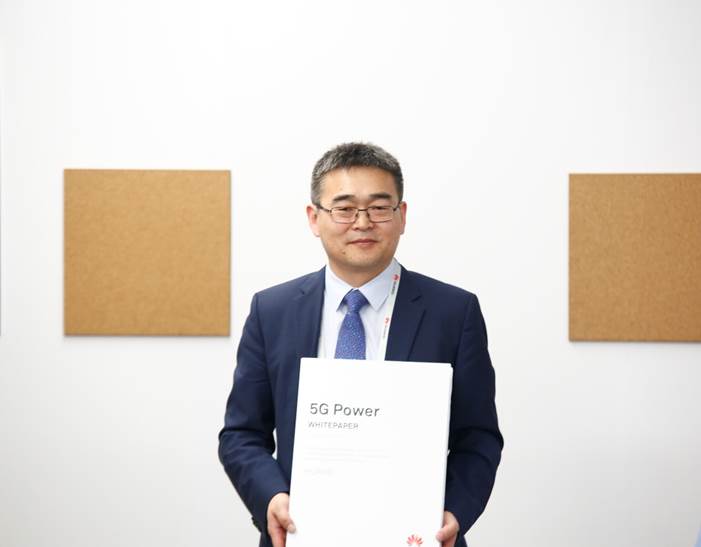[Barcelona, Spain, February 27, 2019] At Mobile World Congress 2019, Huawei released industry’s 5G Power White Paper to analyze the requirements and challenges, as well as the design concepts and scenarios of 5G power. According to the white paper, 5G power needs to be simple, intelligent, and efficient.
According to the white paper, the power consumption of a single 5G site is much higher than that of a 4G site. To meet the service requirements of network capacity boost in the 5G era, a large number of end sites will be deployed, and the power consumption of the entire network will increase exponentially. Carriers face the challenges of insufficient capacity of mains supply, power distribution, and cooling system.
In the future, the number of devices will increase as more bands of higher frequency are configured. Maintenance becomes more difficult, and the labor cost keeps rising, causing higher site maintenance costs.
“In-depth researches on 5G power construction mode are an important and urgent task to address the challenges of 5G deployment on energy and improve the investment efficiency of carriers. We believe that 5G power solutions need to meet the requirements of low-cost deployment, fast construction, energy saving, smooth evolution, and simple O&M.” said Fang Liangzhou, Vice President of Huawei Network Energy Product Line.
Based on a deep understanding of 5G networks, Huawei proposes in the white paper that the design of 5G power needs to be simple,intelligent, and efficient.
l Simple: 5G power needs to be simple. That means 5G solutions need to achieve less footprint, simple installation, fast deployment, and simple O&M.
l Intelligent: Based on the concept of Bit Manage Watt, 5G power uses AI and Cloud technologies to implement multi-level intelligent collaboration between power supply and site devices, as well as power supply and network devices. Functional power supplies develop into intelligent ones,which greatly reduces the CAPEX and OPEX of sites. At the same time, the traditional manual O&M needs to evolve into a more efficient and intelligent one.
l Efficient: Different from the traditional single-component energy-saving design, 5G power requires end-to-end full-link energy-saving design from the aspects of power supply, conversion, power backup, power distribution, cooling, and load. In the power supply phase, various types ofnew energy access are supported to save energy and achieve the goal of 0 bit 0 watt.
The white paper points out that One Band One Blade, and One Site One Cabinet are ideal solutions for various scenarios including the overlay scenario, the site upgrade and reconstruction scenario, a micro base station or a new site. As the technology develops in the lithium battery industry, the lithium battery cost is reduced. Lithium batteries will become a mandatory energy storage mode for 5G sites in the future. The edge computing capability based on Cloud + AI will support the optimal construction and management of 5G intelligent power.
“By analyzing energy pain points faced by carriers in network evolution, we present you 5G Power White Paper. Huawei looks forward to extending the communication and cooperation with the white paper as a base. Huawei is willing to work with carriers and industry partners to promote energy innovation and embrace the 5G era.” said Fang Liangzhou.
Mobile World Congress 2019 will be held from February 25 to 28 in Barcelona, Spain. Huawei is showcasing its products and solutions at booth 1J50 in Fira Gran Via Hall 1, booth 3I30 in Hall 3, the Innovation City zone in Hall 4, and booths 7C21 and 7C31 in Hall 7. For more information, please visit us online at: http://www.huawei.com/mwc2019/
-Ends-
About Huawei
Huawei is a leading global provider of information and communications technology (ICT) infrastructure and smart devices. With integrated solutions across four key domains – telecom networks, IT, smart devices, and cloud services – we are committed to bringing digital to every person, home and organization for a fully connected, intelligent world. Huawei’s end-to-end portfolio of products, solutions and services are both competitive and secure. Through open collaboration with ecosystem partners, we create lasting value for our customers, working to empower people, enrich home life, and inspire innovation in organizations of all shapes and sizes. At Huawei, innovation focuses on customer needs. We invest heavily in basic research, concentrating on technological breakthroughs that drive the world forward. We have more than 180,000 employees, and we operate in more than 170 countries and regions. Founded in 1987, Huawei is a private company fully owned by its employees. For more information, please visit Huawei online at www.huawei.com






